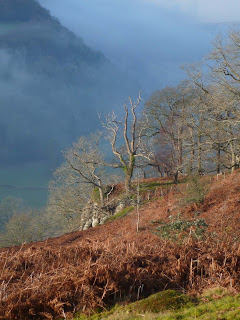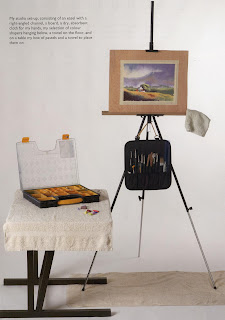




We still have 3 rooms available on my painting holiday to Iceland from 20th to 28th June if any of you are interested in the amazing natural scenery of this fascinating country. There’s no camping involved, although we shall be doing some walking to the subjects which will include spectacular waterfalls, mountains, glaciers, rivers, lakes, lava formations and much more, so it will be a fairly easy way to reach and paint these scenes, many of them world-class wonders.
 The holiday has been organised by Spencer Scott Travel in conjunction with Leisure Painter magazine, so for details either click the link for Spencer Scott above, or telephone them on (+44) 01825 714310. Their email address is info@spencerscott.co.uk if you to write. I shall be demonstrating sketching and watercolour painting techniques, with particular emphasis on creating that marvellous sense of space and distance so common in Iceland, together with methods for injecting atmosphere and light into the subject. The picture on the left of a scene in North America illustrates these aspects of landscape painting. Even though it is only part of a composition it evokes a sense of vast space by the use of cool blue-greys and the tonal range which shows strong dark values in the foreground and only vague, faint ones in the far distance. By limiting the colour range this unifies the scene and creates a feeling of moodiness.
The holiday has been organised by Spencer Scott Travel in conjunction with Leisure Painter magazine, so for details either click the link for Spencer Scott above, or telephone them on (+44) 01825 714310. Their email address is info@spencerscott.co.uk if you to write. I shall be demonstrating sketching and watercolour painting techniques, with particular emphasis on creating that marvellous sense of space and distance so common in Iceland, together with methods for injecting atmosphere and light into the subject. The picture on the left of a scene in North America illustrates these aspects of landscape painting. Even though it is only part of a composition it evokes a sense of vast space by the use of cool blue-greys and the tonal range which shows strong dark values in the foreground and only vague, faint ones in the far distance. By limiting the colour range this unifies the scene and creates a feeling of moodiness.With winter upon us in the UK it is tempting to stay in and curl up in front of the fire with your watercolours, yet there are some lovely days out there when at times, like yesterday afternoon, it was perfect for watercolour sketching outside in the sunshine. What do we do, though, if we’re caught outdoors when it begins to snow or rain halfway through our watercolour?
I always carry around with me a number of Derwent Watercolour Pencils, mainly the darker ones: black, indigo, various greys and a brown or two, and I use these superb pencils to draw into wet washes of watercolour. With this technique I rarely draw an initial outline, simply going straight in with the washes as on this watercolour sketch on the left of Festvagtinden in the Lofoten Islands of Norway. As you can clearly see, rain has enlivened the sketch with many blobs, but the image relies heavily on the marks made by the watercolour pencils.
If you look carefully you will see I have used an indigo coloured pencil for the background mountain and a black one for the buildings and features closer to the foreground. Somehow I’ve managed to avoid any runs into the pristine whites of the snow slopes, mainly by mopping up with a clean, damp brush. Unless the rain is especially heavy the actual pencil line acts as a dam, thus holding off any potential runs.
As well as being able to work in wet conditions, this technique of drawing into wet washes with watercolour pencils also speeds up your sketching considerably as you don’t have to wait around for the washes to dry, so I sometimes use the method in dry conditions. This sketch is featured in my book David Bellamy’s Mountains & Moorlands in Watercolour which if available from our site. See also the excellent Derwent Pencils website. They do a wide range of colours in watercolour pencils and I sometimes just use these for the washes as well as the actual drawing. So if you haven’t tried it yet, get out there and enjoy the winter landscape!

Jenny’s studio set up
The most common criticism of painting in pastel is the problem of dust. This can be a concern if you have breathing problems or are sensitive to dust . I am asthmatic myself. However there are a number of methods of reducing the dust considerably.
On the right is a page from my new book, Painting with Pastel, which reproduces my studio set up. (copyright Paul Bricknell and Search Press)
My three point dust reduction plan is as follows:-
1. Always work with the painting vertical on an easel with a right angled channel, (cardboard or plastic) under the drawing board. This allows the pastel dust to drift down into the channel and you do not have to blow away the excess pastel as you would if the painting was at a shallower angle. If you don’t like standing you can use a desk easel, but keep the painting vertical. You can make an angled channel with a length of mountboard. At the end of a painting session I rarely have more than a quarter of a teaspoon of dust in the channel.
2. Keep a dry flannel in your hands while you are working. This serves two purposes; it keeps your hands relatively clean and you can clean any grubby sticks as you work so that you can identify the colours easier.
3. Work on fine sandpaper; the abrasive quality of the surface grips the pastel and produces less dust than working on paper. Sandpaper also encourages you to work ‘thin’, i.e. use fewer layers of pastel. I find the colours are more vibrant on sandpaper and there is no need to build up layers to get depth of colour.
You will notice in the photograph there is also an old towel on the floor, this also absorbs any dust and prevents dropped pastels from breaking. The towel on the table helps to keep the pastel sticks clean.
The tools in the holder hanging from the easel include colour shapers for blending, brushes for removing mistakes and palettes knives for creating the spatter effect (more on that in another post) etc.
I have been experimenting with Pan Pastels, as you will see from some of my other posts, and have found that they produce much less dust than stick pastels. The method of working in Pan Pastel is quite different from stick pastel and a number new techniques need to be developed. If you want to see some of these, I have an article in the March 2012 issue of Leisure Painter Magazine. (available now)
It’s always a great pleasure when someone famous acquires one of your paintings, and especially so when he is such a great guy with a marvellous sense of humour. Last week Jenny and I were in Cambridge for the presentation of one of my watercolours to best-selling author Bill Bryson by the Outdoor Writers & Photographers’ Guild at the prestigious Scott Polar Research Institute. The event was organised to present Bill with the Golden Eagle Award, presented annually by the guild to someone who has given outstanding service to the great outdoors. As president of the Campaign for the Protection of Rural England Bill has been doing sterling work, especially in his Stop the Drop campaign against litter.
The photograph shows Bill holding the painting with OWPG president Roly Smith on his right and Jenny on his left, while I lounge on Jenny’s left. Others who have received the award over past years include Sir Chris Bonington, Doug Scott and Sir David Attenborough. The painting is always some wild location and has to feature a golden eagle flying across the scene. I once perched high on a cliff in the highlands disguised as a sprig of heather, waiting for an eagle to return to its nest some distance away, but after several hours all I got was a load of ants and vegetation down the back of my neck! On returning to sea level I looked up and saw a pair of eagles hovering over my earlier hideout.